The cards have all been written, the parcels wrapped and all now safely posted, so now, in between cooking for the freezer, my mind can come back to things ‘horticultural’. Following on from visiting two wonderful gardens has made me look at the many different colours and textures of bark that we have in the garden here. I will save the obvious till last and start with the common myrtle, Myrtus communis which has flaking cinnamon coloured bark on top of white.
Hypericum prolificum is another with peeling bark, at times it could almost be Acer griseum, the bark peels so much.
Just beside the Myrtle tree, but wedged against the dead oak, I discovered this nest which I think belonged to a blackbird, only about 3 ft away from the swinging seat where a wren had built its nest this year, hope they all got on as neighbours!
I find the texture on old trees fascinating, this is one of our ash trees, wonderful wood for carving! Hopefully it will be a long time before it has to come down and be chopped up. It is also the best for burning, giving out more heat than other wood.
All our oaks have quite a few burrs on them. I’ve been told that these grow where they have been damaged. The old dead oak has some huge burrs which a tree surgeon told me are worth a lot of money because of the swirling grain that they contain and which wood turners and cabinet makers like to use, for now they can stay safely where they are.
One of our old chestnut trees in the woodland has horizontal stripes in the bark, unfortunately not a good wood for carving or for burning for that matter. We have plenty of chestnut to burn on the wood burning stove but it always has to be mixed with other woods because it doesn’t give out any heat. Two of our trees have fallen over since we moved here, hopefully the others will last a bit longer.
The peeling bark of a silver birch, was used for writing messages in Roman times. Strips have been found at archaeological digs in Northumberland with quite long letters written or even lists for more provisions to be sent to the soldiers at the garrisons on Hadrian’s Wall. This one is Betula jaquemontii and has the most wonderful pristine white bark, and yes, Alberto, I do wash it when it goes green with algae!!!
The willow that we have by the pond, Salix alba Britzensis, gets pollarded every year so that it forms lovely golden stems. It is on the far side of the pond but we can still see and enjoy it from the house.
Prunus serrula, the Tibetan cherry, don’t you just love it, I do! Some people laugh when I say that I give it a quick stroke on the way to the greenhouse, but look how it shines, it’s worth it!
After a holiday in Canada when we stayed with a friend in the Laurentian mountains surrounded by Betula papyrifera, the paper bark birch, we just had to have one in the garden when we returned home. For a few years it has had the tan bark on the left, but this winter it decided to get rid of its tan coat and emerge pristine white, it is beautiful.
Three more young trees at the side of the drive are Betula ermanii, they are still wearing their juvenile coats of browny grey, but hopefully, by next year they will have discarded them and replaced them with the beautiful creamy white bark that they wear in adulthood.
A silver birch seedling arrived unannounced in the garden about 10 yrs ago and was allowed to stay. It is now a fully grown tree and its bark is quite fissured and cracked which means that quite a few insects are able to live in them. This tree is just by the back door and birds are always found hopping around and exploring all the crevices for food. The silver birch is the best tree for wildlife in the UK after the English Oak.
You didn’t think I could do a post about coloured bark without including my red stemmed cornus, Cornus alba sibirica Westonbirt, did you?! With coppicing the bushes we are getting more and more stems each year with bright lipstick red bark. They certainly brighten up a dull day at the side of the driveway and lift the spirits until the snowdrop season starts properly in just a few weeks time.
It was good being tempted out into the garden to take the photos for this post, I wouldn’t have found the blackbirds nest if I hadn’t. The weather today is what I would call raw, cold with wind coming from the north but rain definitely on the way. At least when the weather is bad I can enjoy the coloured bark of my shrubs and trees from the warmth of the house!


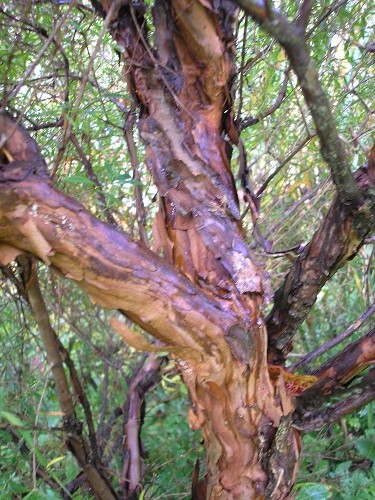
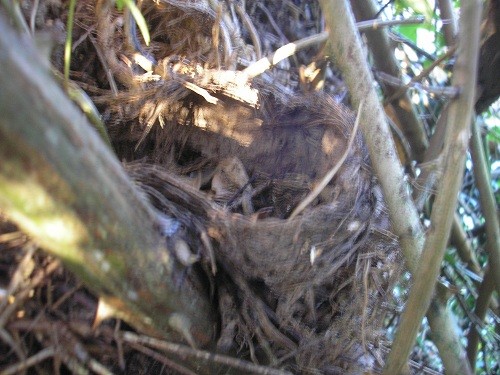

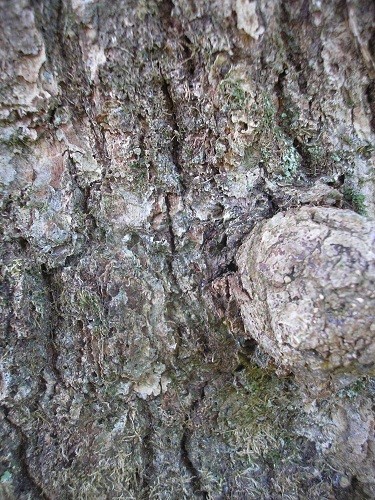


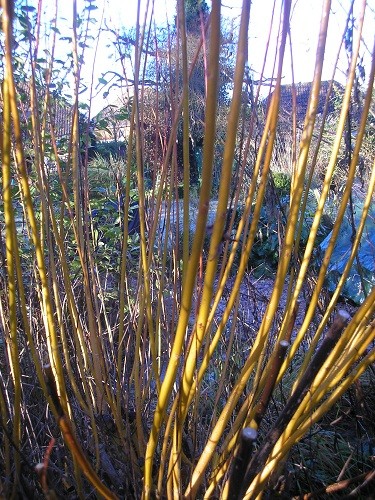

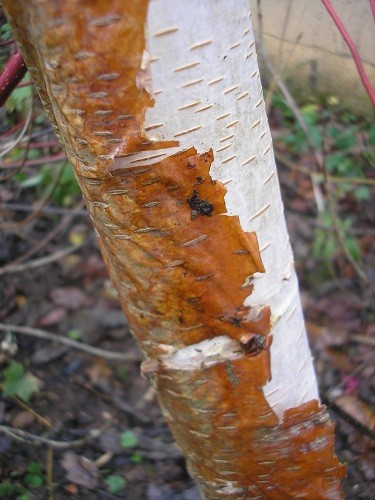



What a lovely informative post, Pauline, and what a lovely selection of trees you have in your garden – makes me wonder if I should have been more adventurous when I planted our little bit of woodland in 2000, but no, at the time I wanted traditional woodland trees and that’s what I planted, so no regrets!
Hi Cathy, I agree to traditional woodland trees in a woodland, just the three close ups of oak, ash and chestnut are in the woodland here, the rest are in different borders round the garden. From a very early age I have loved trees and the more I learn about them, the more precious they become.
Hi Pauline,
Lovely variety of trees; I loved to see gnarled and weirdly shaped trunks, although I would like to have a go at writing on some silver birch bark! 😀
Must have a go Liz, at sending messages on birch bark!! So many times we have seen amazing faces in bark on trees, wonderful how they swirl around and make beautiful patterns.
What a lovely selection of bark andcoloured stems you have shown us! Cambridge Botanic Garena nd Angelsey Abbey, what out, Pauline has everything that is worth having. I miss Cornus, nut it is too dry here, but some of your other offerins are worth considering. Enjoy! Christina
Thanks for the compliment Christina, I like a bit of colour in the winter as you probably can tell! The common myrtle might the only one that is hardy here, but we have seen others in the Med. with much larger flowers, can’t say I noticed the bark at the time!
Hi,
You have many wonderful trees. We definitely lack some trees in our garden, and I especially like the silver birch and the prunus serrula. The cornus also looks great with the red colours.
Hello Gitte, glad you like our trees, we have lots of old native trees in the little woodland, others I have planted round the garden. We love the red cornus in the winter, it brightens up a dull day!
Fascinating collection of trees you have Pauline. The Tibetan cherry bark color is sumptuous.
I agree pbm, the colour of the bark of the Tibetan cherry is amazing, just like a mahogany carving, and so tactile too!
Winter bark is a big asset to the garden and often ignored. We have a few large London Plane trees and I love the way their bark flakes off in big chunks.
Hi Lynne, thanks for stopping by. I’m in favour of anything that brightens up a dull day and in the winter months we are so lucky to have a good selection of coloured bark, they certainly bring a smile to my face! Lovely patterns can be found when trees shed their bark, I can imagine your plane trees look beautiful, must have a look next time I am in London.
Winter is a great time for admiring bark, and you have shown some of the best. White-barked birches don’t survive our summer heat in Pennsylvania, but thrive in Maine.
What a shame Carolyn that you aren’t able to enjoy the white barked birches, I’m sure you have something else though that looks as good, or I hope you do!
A most informative and enjoyable post Pauline. You have some fine specimens in your garden which much give you much pleasure, as well as the birds and other other wildlife that visit your garden. I did not know that the silver birch was so high up in the attractive to wildlife league. That’s good to know as we are thinking of introducing one into the garden. It’s amazing to think that messages on bark have survived since Roman times – my mother is from Rome so it could have been one of her long ago ancestors writing that shopping list 🙂
Anna, I think once the bark of birches becomes old and fissured, that is when the creepy crawlies move in and the birds can start to enjoy them. My hybrid birches are quite young at the moment, so their bark is still smooth, so I don’t know if it applies to them or just our native birch. We have just one native birch, be warned, they seed everywhere!! We saw the shopping list in a museum on Hadrian’s Wall, it was fascinating learning about everything and seeing just what had survived all this time, I can also remember a fantastic pair of leather sandals!
Just catching up with posts I haven’t got round to reading. I love all the different barks out there. I’m a particular fan of Prunus serrula. If I had one I’d be stroking it too. 🙂
Thank goodness WW, that there’s someone else out there like me, Prunus serrula is so very tactile, just can’t resist it! With having so many huge native trees, I have only been able to plant a few decorative ones and they really have to earn their space and have more than one season of interest, so far I’m happy with my choice.
Very interesting post Pauline. I wonder why the wood of a chestnut tree gives off no heat? It must have something to do with its chemical composition. My favourite barks of the ones you have shown would have to be the Tibetan cherry (so smooth and shiny!) and the silver birch ( Birch trees are always a favourite).
Jennifer,when two of our chestnut trees fell over, we thought, never mind, we wouldn’t need to buy any wood for the wood burner, but were so disappointed with the lack of heat generated, it just had to be mixed with other wood to keep us warm! We love our coloured bark too, it really shines out on a dark winter’s day.
Hi Pauline! There is always something showy in your garden! I am officially in love with that silver birch, I realized how much I like birch trees reading your posts and now I want more than the two b. nigra I own. I grab some cornus cuttings (some deep red and some yellow) in a park a few days ago, I thought of you and your cornus!
Alberto, I’m sure it must have been one of your ancestors who was writing the shopping list on the birch bark, very resourceful!! Your cornus cuttings will look super in a few years time, I am finding that branches flop down and root themselves, making more free plants, fantastic!
The bark colours and textures add a lot of interest to the winter garden. I love the look and feel of trees with their individual markings. Your Prunus serrula has a fabulous colour as well as glossy look, and your red Cornus stems are very eye-catching.
My birch tree died, but I keep the double bole, because they are still beautiful, and woodpeckers still like to visit and check out what is under the bark.
I agree NS, that the winter garden wouldn’t be nearly as interesting without the coloured bark and stems of the trees and shrubs.
Sorry to hear that your birch tree has died but I’m sure the wildlife still loves it and I’m not surprised your woodpeckers find lots to eat under the bark. Woodpeckers , nuthatches and treecreepers explore under the bark of our dead oak, there is obviously lots for them to eat!